“I’m not a gear man – never have been. Give me something with six strings, keep it in tune, and make sure it’s working!” – Jeff Healey
In all the years I knew him, no matter what rig he was playing through, whose borrowed guitar he was using, what band he was sitting in with… Jeff Healey, inevitably, unswervingly, always sounded like Jeff Healey. It was remarkable. I used to half-joke that his tone rested solely in his hands.
Now, a good deal of that is true. Certainly, Jeff’s phrasing, his unique ability to pull off tremendous string bends and crazy vibrato with ease… his style, though rooted in familiar backgrounds, filtered through his own sensibilities to create that ‘Jeff Healey sound’.
For the most part, Jeff treated his instruments as tools. There were times he had to be pleaded with to bring guitars out of the garage and into the house! However, despite the above quote from Jeff, he did have some favourite go-tos amongst instruments and gear. Due to an overwhelming amount of recent requests, today we are going to dig a bit into this aspect of Jeff’s career. (whilst leaning mostly on our good friend, Rob Quail, with a little help from guitarist Dan Noordermeer and Jeff’s long time tech, Bungie)…
Now fear not, if you aren’t a ‘gear head’ or musician – you’ll still have Jeff’s own words, some cool memories, and some pretty pics to see you through… 🙂 ~Rog
***
GUITARS:
Rob Quail (friend/guitarist/bandmate):“His first ever electric was a maple (yes, maple: body, neck, even the fretboard) SG copy with no logo on the headstock. His dad bought it for him at Hudson Music, a great little guitar shop that used to be in the west end of Toronto, not long before Jeff and I met.

His second electric was a black Japanese ”SQ-series” Squier Strat, with the big, 1970’s style headstock and a maple fretboard; he and I each bought identical guitars the same week in late 1983. Jeff only owned his for a few months; I still have mine; his now belongs to a friend of his ex-manager. Jeff bought that guitar at a store that used to be in Etobicoke, called Seagully Sound.
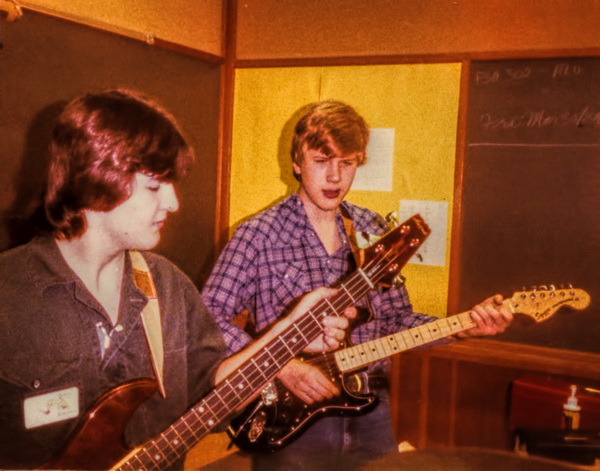
His third was a Japanese Contempora Squier, red with two humbuckers. Nobody seems to have any idea where that went. As I recall he bought it at Musician’s Supply in Mississauga, Ontario. That would have been in late 1983 or early 1984. After he met Stevie Ray, Jeff started using heavier gauge strings, from a 10 or 11 gauge on the high E down to a huge 56-gauge low E.

Then there was a tobacco-burst MIJ Squier bought in about 1985 from Millwheel Guitars in Toronto…
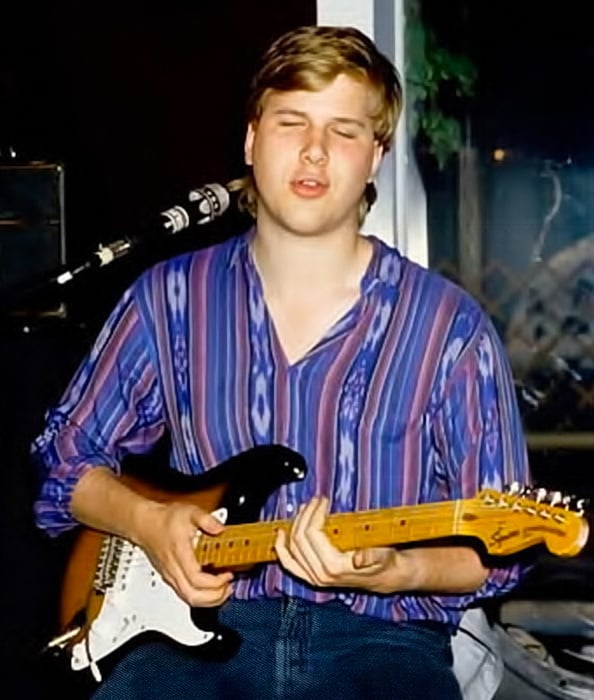
That was his first Japanese JV Squier, which is the type and model he used for much of his career.
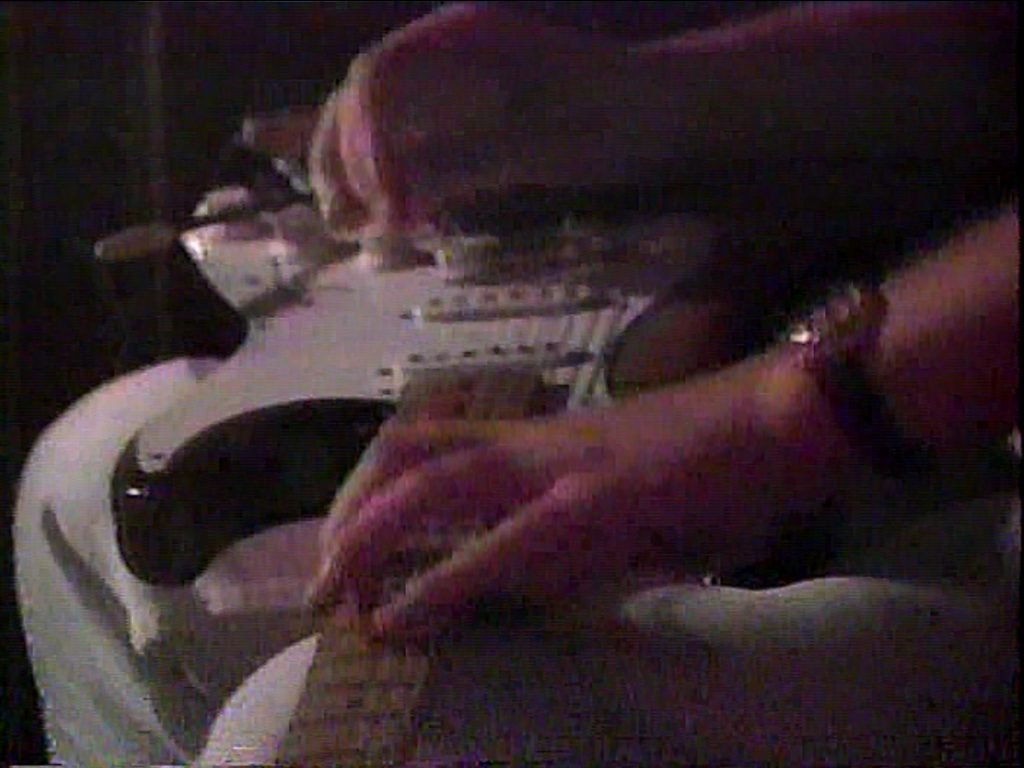
But, during the commercial peak of the JHB, for the first few records and the movie Road House, he was using black JV Squiers with red single coil Evans pickups. They were solid alder. Those Japanese Squiers were great guitars.
Much is made of the fact that Jeff played Squier guitars. Jeff started playing Strats in the early 1980s when quality control of Fender US was probably at its all-time low; Fender was getting killed by import brands like Yamaha, Ibanez, and Tokai, and so they started their first offshore guitar manufacturing in Japan under the “Squier” brand to try to get prices down and compete with the imports. Those early Squiers were great guitars. Since then, the name Squier has been mostly associated with really low-dollar, entry-level guitars. But the thing to understand is that in the early to mid 1980s, the best guitars with the “Fender” name on them, at least according to Jeff, were those early Japanese Squiers.
I never knew him to own or play a ‘70s Strat or mess with different pickup brands; in fact he hated Strats of that vintage, and very much preferred Japanese ones from the ‘80s.
Jeff stayed loyal to the Squier brand for most of his career.”

Jeff Healey: “They’re generally stock except that I’ve changed the pickups and put in some made by a fellow in Victoria, British Columbia, named Rod Evans, who’s made an improvement on the original things. His single-coil pickups to me, are the perfect combination of the standard single-coils and the humbuckers. I love them. They sound wonderful.”
William Furlong (fan/guitarist): “The Rod Evans pickups started out as standard production units with the quick connectors on the back of each pickup. Then later on they were made hardwired with no connectors. The pickup wires went straight into the epoxy on the back, so Jeff could stand on his guitars and the pickups wouldn’t come out of their clips…”
RQ: “I played Jeff’s guitars quite a few times through that period through a variety of amps and I can say the Evans Eliminators he was using were “fat” sounding pickups with a lot of midrange and output. They were very impressive in terms of their ability to avoid background noise and hum, which was very important given Jeff’s tendency to use gobs and gobs of gain and volume to get his sound onstage. Regular Strat pickups would have been unusable through his rig.”
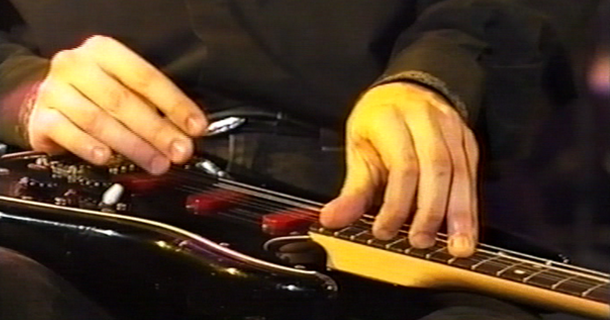
JH : (1989) “(I can get everything I want from one guitar), a black Fender Squier Strat that I have which is my favourite. All of my guitars have the Canadian-made, Rod Evans pickups, but the black one is the guitar that I like most. …I tighten (the tremolo system) right to the body. I don’t like (locking systems). They’re a pain.”
RQ: “That black Squier Strat that most people associate with Jeff, with the red Evans pickups, is gone. As a part of his show he used to toss it around and jump on it and stuff. The body got re-glued back together so many times that it finally got scrapped. I don’t know where he originally purchased that guitar.”
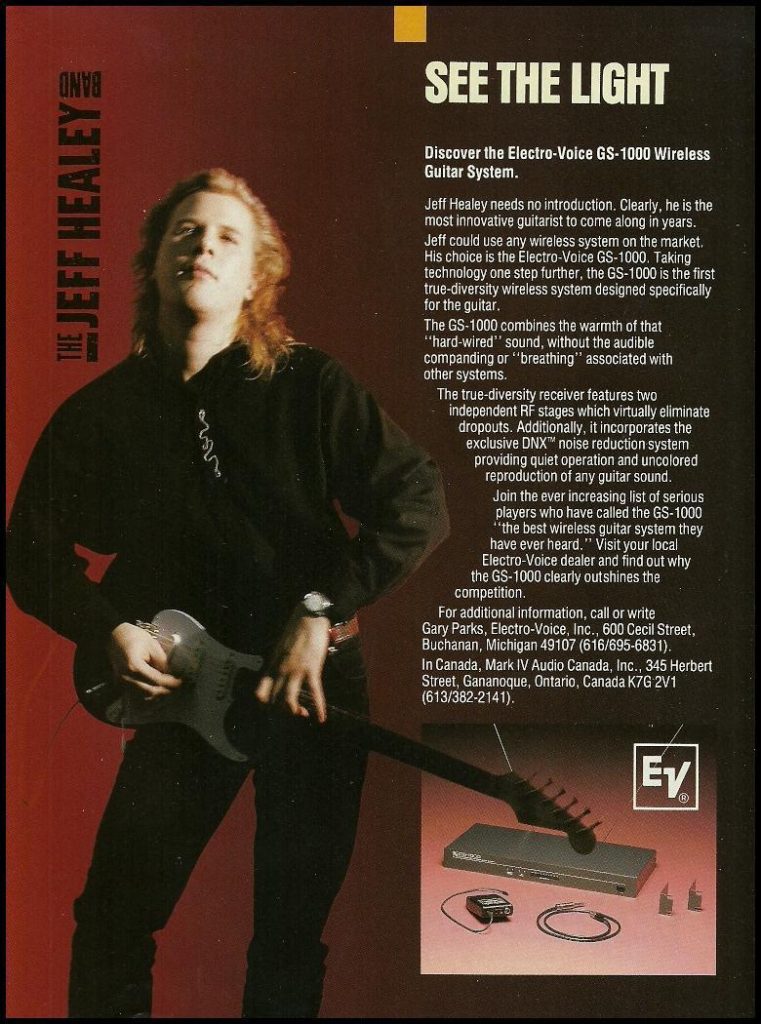
RQ: “Jeff used wireless systems for a few years but didn’t like the tone loss so he went back to a cable.”
JH: “(It’s) the Electro-Voice wireless system which was just introduced to the market (in 1990 – Prior to that, Jeff was using a Nady Wireless System ~Rog). I’m using a wireless implant in my six-string guitars; for my double-neck Jackson, which because of its many workings, has no room for an implant, I use a belt pack.”
***
RQ: “He also had a Jackson doubleneck (with joined headstocks), which he used onstage before he added a second guitarist to the touring act.”
JH: “I bought that in Los Angeles… It’s a beautiful thing and it has the best 12-string neck on it that I’ve ever experienced on any guitar. I decided that I wanted to get one, and I went through several guitar stores in Los Angeles trying Ibanez ones and Rickenbackers, and I hated all of them. I had almost abandoned the idea when I stumbled across this Jackson which was a make I’d never heard of. So, I tried it out, it had everything on it that I wanted. I could play both necks at the same time… if I had four hands… It’s perfect.”
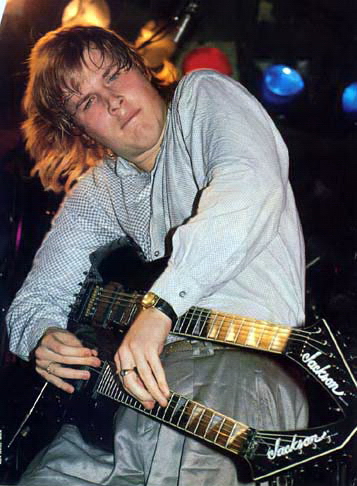
RQ: “It’s a Jackson Custom Shop “Siamese” Doubleneck. He bought it at a Guitar Centre in LA while they were recording the See The Light album and the Road House soundtrack. There are not a lot of examples of this particular model. The joined headstocks make truss rod adjustments complex, and the guitar weighs a ton. About 18 lbs. Of course, because he played sitting down, weight wasn’t a factor for Jeff. (except when he was playing it behind his head! lol. ~Rog)
12/6 string, upper neck is the 12 string. The lower, 6 string neck is basically a Jackson Soloist, with an old Kahler double-locking vibrato and two humbucking pickups, originally Jackson pickups but later changed to Seymour Duncan SH-5’s. The 12 string neck is very unusual as 6 of the strings are configured normally and 6 are “backwards” with the ball ends in a little tailpiece at the headstock end and the tuners mounted on the guitar’s body.
The 12 string side has two single coil and one humbucking pickup, again originally Jackson pickups. Jeff changed the two single coil pickups for the red Evans ones he used in those days and put another SH-5 humbucker in place of the original bridge position humbucker. Jeff used standard tuning on all his guitars. He used DH strings; the same “JH” 10-56 sets he used all the time on the 6 string side and the 12s were just standard light 12 string gauge.
Jeff gave me that guitar about a year before his death.
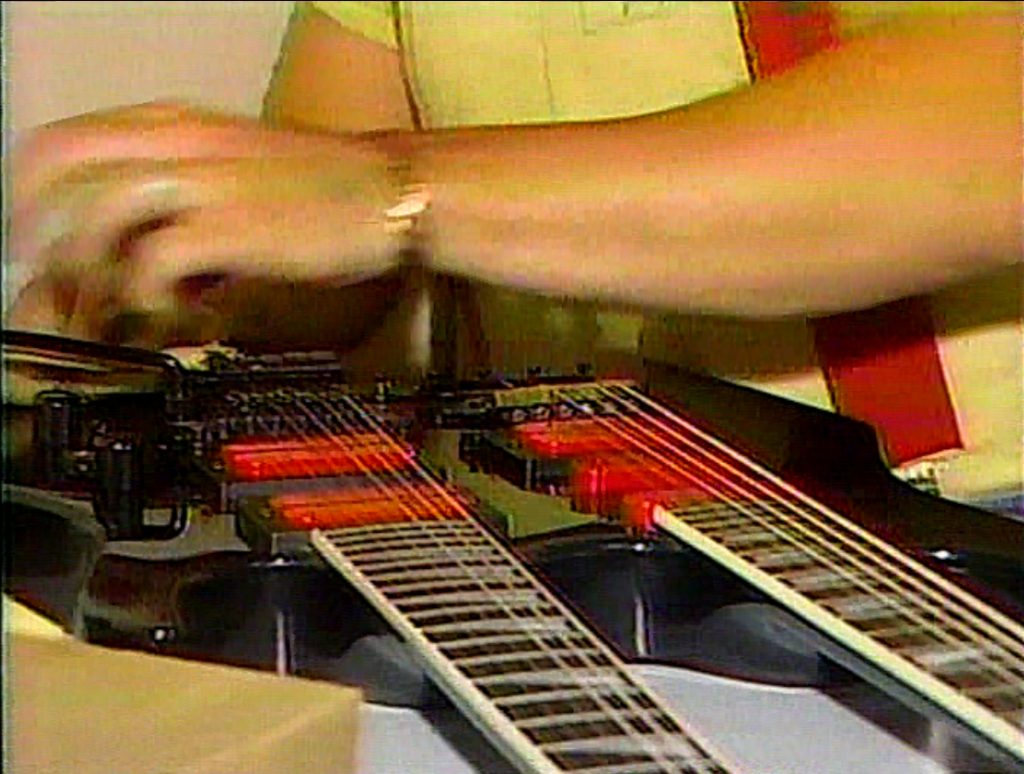
***
After the original black Strat got trashed, Fender approached him for a signature model, and they made a couple prototype Jeff Healey Signature instruments that were replicas of the black one, with Fender’s then state-of-the-art Lace Sensor pickups and Squier logos. Jeff didn’t like either of them and gave them to another close friend (and great guitarist) Pat Rush, who still has them today.
Jeff had and played a Les Paul for a while in the late 1990s but it was sold when they disbanded the Jeff Healey Band as part of the liquidation of the band’s assets.
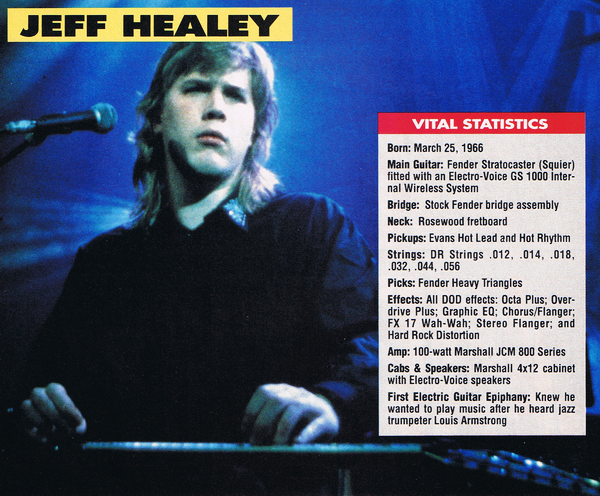
Later on, from about 1999, Jeff switched to Contempora-bodied custom-shop-built Squiers with three humbucking Evans pickups (later switched to Seymour Duncan SH-5s) in them and some pretty wild wiring that allowed him to coil tap individual pickups one at a time. He could individually tap a single coil on any combination of the three buckers, plus there’s an extra switch that allowed him to get neck + bridge and all three pickups. Plus, there’s a “brightness roll-off” in place of the second tone control, designed by guitarist, Pat Rush.”
JH: “I’ve designed it over the last few years. It has three double-coil pickups, all of which can be split into single-coils. You can get a combination of any one, two, or all three. You can combine all sorts of Strat configurations – front and middle, back and middle…”
RQ: “Jeff had a friend draw up a schematic for this, his “dream guitar”. He sent the schematic to Fender and said “this is what I would want as a signature model.” Fender made a couple and sent them to Jeff, but also said that there’s no chance that there would ever be a market for such a complex guitar, especially marketed as a Squier, and shelved the whole idea. “
JH: “I’ve talked to a lot of the major companies [about marketing it], but no one seems interested in picking up the idea. They felt that in order to do it, they’d have to put too much money into designing it that way, or that nobody would be too interested.”
RQ: “Jeff told me he thought they were nuts not to market it; that such a flexible instrument would be a huge commercial success. (Personally, with all due respect to Jeff, I’d side with Fender on this; it was a pretty intimidating guitar to try to figure out.)
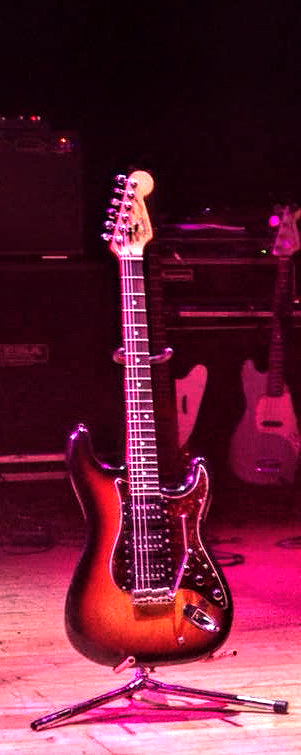
At the end, and for the recording of Mess of Blues, he used a conventional-bodied US-made Strat with the three SH5s and the same wiring config as above. For some reason he had the pickguard recessed so it was flush with the body; I didn’t discover this until after he had passed so I never was able to ask him why he had that modification done. “
Bungie (Guitar tech extrordinaire): “I did that, as per request by Jeff, I believe he just wanted it to be more like the prototype Squiers he was working on!
We were trying to get that one as close to what he wanted to be able to show Fender exactly what he was thinking and he hated hitting the pick guard edge with his pick when going for it!”
RQ: “For Jazz shows, Jeff played a 1940s Gibson L12 archtop. He kept that guitar on his porch all winter; I was always bugging him to store it in a heated, secure place, but to him it was just a tool.”
JH: “I’ve had it for about 10 years. I added a pickup to it. It still has a nice acoustic sound, I just wanted certain “electrified” sounds, if you will. I don’t remember exactly which pickup we put on it – it’s an old, large-looking thing. (I run it through) a little Fender Pro Junior – it has your two basic controls – volume and tone.”

***
PICKS:
RQ: “Jeff always used those huge, triangular picks, Fender heavy gauge. I think they worked best for the mechanics of his picking technique, with the picking hand hovering over the strings. He always had a couple of those picks in his pocket, I guess because regular shaped picks didn’t suit him, and he never knew when someone might hand him a guitar to play.”
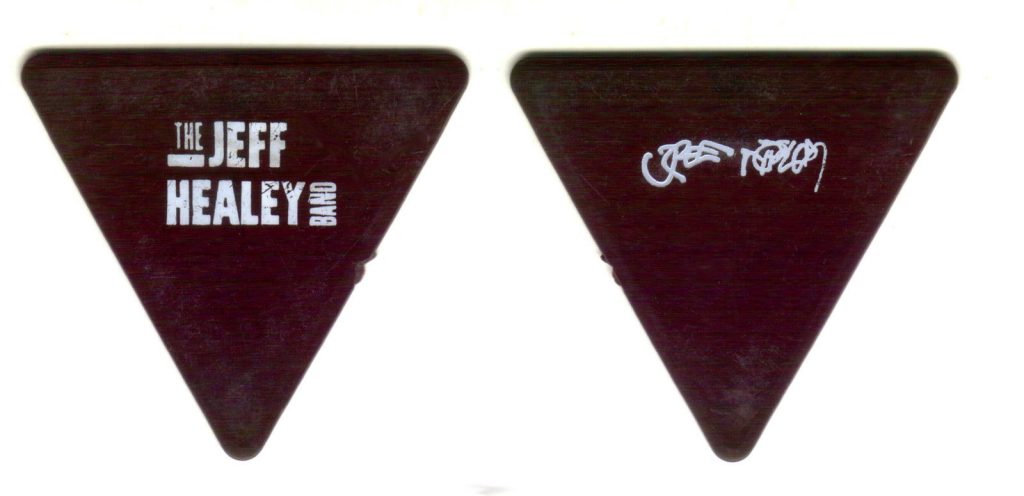
JH: “It’s just been comfortable for me. Back when I was a kid, all that I ever used was a thumbpick and I never liked the smaller triangle picks at all. But somebody left one of these big triangles on a stage I was playing when I was about 13 and my dad gave it to me after the show, just to say, “Look at this — this is funny.” And I tried it and felt very comfortable with it so I continued to use it and started buying them.”
***
AMPS & Pedals:
JH: (1989) “I use Marshall 100-watt heads, and 4×12 cabs. The effects are just a Tokai overdrive, a Boss EQ, and an MXR flanger. As for playing live, I’m trying out a set of pedals at the moment made by DOD that they want me to use, and they’re great. That’s overdrive, distortion, octaver, flanger, EQ, and digital delay as well as wah pedal.”
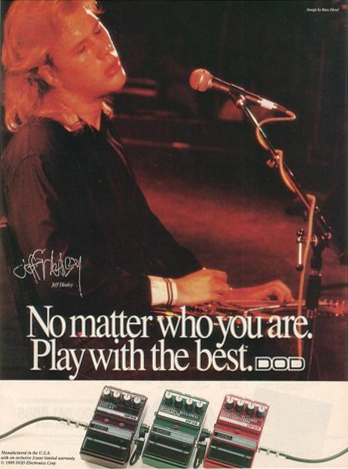
RQ: “As far as amps, Jeff used a Marshall JCM800 half-stack in those early days; then later a ProTube Twin, and a pro junior that he used with the Jazz Wizards. For a while Jeff had a Matchless Super Chief. He never liked it though and it was sold on eBay around 2005. In the very early days of Blue Direction, Jeff played a Traynor Guitar Mate. Also Jeff owned a Peavey Bandit 112 for a few years, before he got is first Marshall. That amp was a total piece of crap but Jeff was able to make it sing, because he could make anything sing.
Jeff hated reverb. Any time he plugged into an amp with reverb, the first thing he would do is turn the reverb down to ‘0’.
People were always giving Jeff gear to try out or use, but most of that stuff disappeared. I remember being at a birthday party for Jeff where someone gave him an original TS808 Ibanez Tube Screamer Overdrive pedal. But as far as I know he never used it and it has since disappeared.
In his heyday, he played thru DOD effects (which he endorsed) then later he switched to BOSS pedals (Bluesdriver compressor/sustainer, chorus ensemble, digital delay, GE-7) and Vox wah, into Fender Protube Twins (or the Blackface ‘65 reissue Twins, when he was on the road and couldn’t find a Protube).“

Dan Noordermeer (JHBB/Healey’s House Band Guitarist): “The pedal board in this pic is almost exact to what he still used up until his passing. R to L – Boss Power Supply, Boss Compressor, Boss GE-7 Graphic EQ, here is an Ibanez Tube Screamer(I suspect) later on to be switched out for a Boss Blues Driver, Boss Chorus and finally a Boss Digital Delay.”
RQ: “Jeff always played extremely loud onstage and always set up his amps clean, but very VERY loud, and got all his grit from pedals. He liked to use extreme settings on the pedals so his signal would hit the input stage of his amps really hot.
Basically anything in the signal chain that could increase gain, Jeff cranked. Blues Driver, GE7 graphic EQ, compressor… Then he set up his amp, which in the final few years was a Twin, really loud and clean, and he sat close to it so he could get all kinds of outrageous feedback effects.
The way Jeff used his GE-7 graphic EQ tells you pretty much the whole story about how Jeff used pedals. That pedal has a row of sliders, each of which can be used to cut or boost a different frequency, and then there is a “gain” slider on the right that just boosts the output overall. Most people buy those pedals to sculpt their guitar’s tone; maybe boost some bass or cut some shrill highs out. Not Jeff. He kept all the sliders in the middle, in the neutral position, except the “gain” one on the right, which he put all the way up. So basically, he used his EQ pedal as a “make it louder” pedal.
Jeff preferred the unusual (and very heavy!) Fender Protube Twins over the much more common 1965 reissue Twins. Partly because they sounded better, but also because they didn’t blow up as often. I remember Dave Murphy saying something to me about how astonished he was at how often Jeff would blow up amps while they were out on the road.”
DN: “I felt Jeff preferred (the Twins) over Marshalls at this point when I was with him. He definitely blew up quite a few over the years. There was one occasion overseas where he had blown the main amp and was using the supplied spare amp, which he also blew! I immediately unplugged my guitar, gave him mine and sat in the wings for the rest of the show. No one’s paying to see me imitate Jeff while he just sings!
(As mentioned earlier) Jeff had a Boss Compressor on his board, which is traditionally used to smooth out your sound by squishing the high and low tonal spikes. He, however, had it set up to be dimed out and create sonic chaos into the preamp. Just turning it on would make his signal squeal bloody murder, but he had an incredible ability to use the mayhem quite creatively! I was never surprised, though, at the amount of times this fried the Fenders by the end of a wild night.”
RQ: “On the Live tracks of Mess of Blues you can hear the difference in tone between these two amps. “How Blue Can You Get” and “Like a Hurricane” were recorded at Healey’s Roadhouse, through the Protube Twin. While there is plenty of distortion, there is a more controlled, focused sound. The other live-in-concert tracks were recorded on the road, through rented 65 Reissues. You can especially hear the amp begging for mercy and sounding for all the world like it is going to blow up at any minute at the end of the solo on Sitting on Top of the World.
The thing to appreciate about Jeff’s approach to electric blues-rock guitar is that, probably more than any guitarist since Jimi Hendrix, Jeff treated the guitar, pedals, and amp as a single instrument. He was a wizard at controlling the strings. That’s why he liked to set things up onstage the way he did: amp very close by and pointed pretty much right at his hands, cranked way up insanely loud, with every pedal on the board that could possibly boost the signal cranked up all the way (many of us really worried about his hearing). This way, he could take full advantage of the way the strings and the guitar’s body would vibrate sympathetically at these tremendous volumes, create sustain and feedback at will. Really allowing him to sculpt the notes.
Mike Daley and I have shared stories about the few occasions where we attempted to play a little through Jeff’s stage rig as he had it set up, and all either of us could get was squeals of feedback.”
***
Jeff Healey quotes;
Vintage Guitar – June 2002 – Interview by Arlene R. Weiss
Guitar World – Sept. 1990 – Interview by Harold Steinblatt
Guitar Player – Aug. 1989 – Interview by Jas Obrecht
Guitarist – May 1989 – Interview by Rick Batey
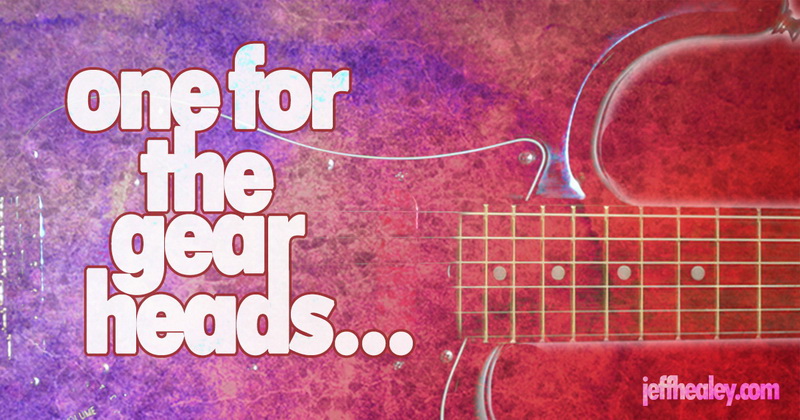


Thanks for putting this together! Indeed Jeff always sounded like himself no matter what the situation and equipment. Its also a story of experimentation and observation over ‘buying the name brand’.
A wonderful talent, sadly missed.
This was so interesting. Thank for posting this! I just happened to notice the date on the 11th picture. I was at that show!! It was my first concert and Jeff was awesome!! 9/9/90. The Warfield SF Cali.!
Great article for a great guy and music player. I love Jeff Healey music. God bless
God bless his greatness. RIP Jeff Healey
Incredible article. Thx Rob for the memories. Wowzer
Great piece of history.Thanks so much for sharing’.
Tecka’
What an interesting read. I love Jeff’s music, my favourite blues artist thanks for sharing.
I wish we still had Jeff with us today. He deserved so much more. He sounded so good through his Marshall 800 amps at the festivals man it was like seeing Jimi Hendrix in a way it was that good. The blues driver through that amp or tube screamer man what a tone. I think he had so much more in him. Losing his most beloved guitar had to be hard. RIP Jeff Healey.
Thank you for all this great information, on one of the greatest guitar players ever. God I miss him so. RIP my friend
I have waited years for a breakdown of Jeff’s rig. I saw him twice in Glasgow, Scotland and they were two do the best gigs I’ve ever been to. Thank you for putting this together. The level of detail is amazing. I love the insight that Jeff saw his entire setup as one instrument.
I love and adored him although I didn’t really know much about him till after he passed.
Thanks so much Rog and guys for putting this together! In a world focused on “equipment fetish” these days, this is such a great reminder what really matters. But given Rod Evans isn’t making pickups anymore, we may see a run on those! https://www.synapticsystems.com/studios/evans/evans.htm BTW, I laughed when you mentioned the Peavey Bandit – I had one in my early band days and abused the heck out of reverb.
Thank you!! Jeff was/is amazing. I got to roadie for him in Dallas in 97? Great guy. Miss him.
I have a photo of Jeff playing his black Strat with the red pups. The guitar also has something resembling a key fob on the pickguard. This has perplexed me for quite some time. Someone must know what it is. I don’t think it’s possible to post the photo on this site but I can email it if anyone’s interested.
Barry! Loooong time coming, but here’s the definitive answer straight from one of Jeff’s old techs. (This took a while ’cause no one could remember this damn thing! Lol!)
Ok , so it’s a car key fob!
His tech at the time Farns (Jon Farnsworth ) came up with a way for Jeff to turn certain pedals (ie.EQ-compressor) on and off when he would stand up and run around! His guitars were also wireless at that point with the transmitters mounted inside the guitars.
There was a receiver on his pedal board, that acted as the relay to the pedal switches there by turning them off and on, like unlocking and locking your car!
(Oh and the red button lower left by the output Jack, turned the wireless on and off!)
😀 ~Rog
I very much appreciate all the trouble you went through to respond. Much appreciated.
Shoot! I just actually read the entire site (should’ve done that first ♂️
The photo I have is the last one on this site where Jeff is standing with his pedalboard on the floor and next to his Marshall. Look closely at his pick guard and you’ll see what I’m referring to. It’s underneath the middle and neck pups.
BARRY:
My best guess is that’s one of those plastic spring-loaded pick holders/dispensers. I’d also bet it got in his way and didn’t last for long (or got crushed the first time he stood on it).
COLUMNIST:
Thanks for writing this. I came here basically for spec info on the JH signature that never happened. I knew a good part of the rest, but still learned some things.
WEBMASTER:
There is a link to an article on the main page as to “Why Jeff Still Matters.” He was an accomplished musician and singer who wrote, recorded, and performed some wonderful music. One of my favorite guitarists of all time. No qualifiers necessary (and I’m not even Canadian).
Thank you for this article! I saw Jeff live at The Breakers in Point Roberts, Washington, when I was living in South Surrey! It was my only American located concert and ironic considering he and I both being Canadian. I can only recall that it might have been my first or only opportunity after officially hearing of him, as well as seeing his live in London video etc!
What amp is Jeff playing through in his 1988 Tonight Show/Johnny Carson appearance? It looks like a Dumble, anyone know? https://www.youtube.com/watch?v=vbey_Cwk7bs
That’s his Marshall JCM800, turned around and facing backwards. Presumably they did that so as not to deafen the crowd, and to help manage the amount of guitar “bleed” into Jeffs vocal mic. Note they could have just pointed the speaker cabinet backward but kept the head facing toward the front of the stage, so am guessing that, after hearing how loud Jeff played during sound check, someone on the show’s production crew just picked the whole amp up and turned it around 180 degrees. Hilarious.
That trick, of facing the amp backward, was something Jeff used to do sometimes when bringing his Marshall into a smaller club, so he could crank the hell out of it without killing anyone with the volume.
I just watched the “live in Montreux” DVD with my son, and it hit me that I really liked his sound so much… I saw him live too, one of the most impressive shows ever… Thank you for putting this together….
Very cool to read about his guitars, amps and pedals that helped him produce his sound. As we all know, Jeff could have played a low end toy guitar and made it sing like a $5000 Vintage instrument. Sure do miss seeing Jeff live. I`ve lost track of how many times I saw him live, basically every time I had the chance to see him I did…..God Bless
i have a qustion the see the light picture of the band shows jeff with a what looks to be a white strat what and were is it
Hi Curtis. Best guess, it was either a back-up guitar, or something that was brought in just for the shoot so there’d be a guitar there for Jeff to hold in the pics. Either way, looong gone I’m afraid… ~Rog
Has anyone else but me ever seen that Fender poster ad from the 90’s that read:
“Win a guitar just like the one that Jeff Healey plays”
The wild thing was, that he had a Fernandez guitar in his lap in the picture.
A guy I worked with grabbed it before I could, but I’ve never seen any mention on the internet about it ever existing. The store I tech’d for got it as a promo.
Fascinating reading. Many thanks for taking the time to post all this info brother x. I first saw Jeff’s captivating band live at Rock City in Nottingham (UK) circa the early 90’s. Me and my friends who who were thinking about learning to play guitar and form a band etc got a serious reality check as Jeff and the band flew straight into that instrumental “The Better It Gets”.
After that opening song we were like “F*uck!….maybe we should try fishing or something instead?” lol Out of all the info you shared I was pretty shocked to read Jeff hated Reverb.
Did he use Delay as reverb then? It seems quite a few people do and on a amateur level I do myself ( I decided to give guitar playing a shot in the end and wound up forming my own band lol)
Jeff’s guitar playing was a captivating tour de force but one thing that really stood out and was noticeable to my ear was the way his vocals just got better and better. Don’t get me wrong, he could always sing and sing coolio, but as the years went by since the first album “See The Light” he ended up in later years being a proper soul man vocally. Great depth and richness to his voice.
Maybe just an ageing thing, right? Still….it was coolio to hear his vocal prowess develop. He had it all and life was taken away from him waaaay too soon. Such a sad loss for his wife, family/friends and the people that loved his music.
Much love from a UK based Jeff Healey fan XX
No, Jeff only used delay occasionally. He just preferred a dry sound coming out of his amps.
Totally agree about the constant improvement of his singing ability.
The 1947 Gibson L12 Archtop was purchased by Jeff from my father. I contacted Jeff’s family after he passed and after being horrified to read (here) that it was kept ‘on the porch’. They said the guitar was one of Jeff’s favourites and it was properly stored and taken care of when i inquired as to whether I could buy it back or not. They said they would never part with it.
I just rewatched the Original and best Roadhouse, and found out about Jeff Healey. Great article and fun to learn about someone so talented.
Jeff was an amazing guitarist, singer, and human being. A fantastic example of overcoming adversity and excelling in the face of it.
Great article and thank you for this! I saw Jeff in Ballard Washington at a little club called The Tractor in late 1999. Of course he blew the roof off the place. One of the best concerts I have ever seen in my life. Squire strat with red Evans pickups into a Marshall half stack cranked. God bless you Jeff! Wish you were still here with us making music!
I was at that show in Ballard. It was amazing.
Hi great reviews on the guitars. Do you have the detailed specs for the black JV with Evans pickups the KS on the pickups neck radius 7.25 or 9.5 size of frets how many springs in the back he used with or without z back cover string sizes in 1988 89 he used.
Thank you
No, sorry… ~Rog
That was an E-series Squire. 7.25 neck radius, originally with vintage-style frets.
Lucky enoulgh to still have one of my 90’s?? Fender japan 60’s reissues, very close to the JV squires,(I have been told they are the same other than electronics_) Great guitar and a lot of my die-had strat guys love it, redid the pickups to slightly hotter than stock and it rips. Great buy if you can find one, they are around, just have to dig!!!m Just rediscovered Jeff after hearing him on the radio, Man!!! What a talent.!!